Table of Contents
Iran is home to one of the richest cultural heritages in the world. With 28 UNESCO World Heritage Sites officially registered as of 2025, the country offers a fascinating journey through thousands of years of history, art, architecture, and natural beauty. From the ancient ruins of Persepolis to the peaceful beauty of Persian Gardens, each site tells a story about Iran’s deep-rooted civilization and its influence on the world.
UNESCO designates these places as World Heritage Sites because of their Outstanding Universal Value. They are preserved not only for Iranians but for all humanity—showing how Iran has been a bridge between cultures, religions, and empires throughout history. Whether it’s the spiritual atmosphere of the Armenian Monastic Ensembles or the advanced engineering of the Shushtar Hydraulic System, these landmarks represent the creativity, skill, and diversity of Iran’s people across the centuries.
In this article, we’ll have a complete and up-to-date list of Iran’s UNESCO World Heritage Sites for your trip to Iran. Each entry includes a short introduction to the site’s importance, helping you understand why it has earned global recognition. Whether you’re a traveler, a researcher, or just curious about Iran’s cultural treasures, this guide offers a valuable starting point for discovering the wonders of one of the world’s oldest civilizations.
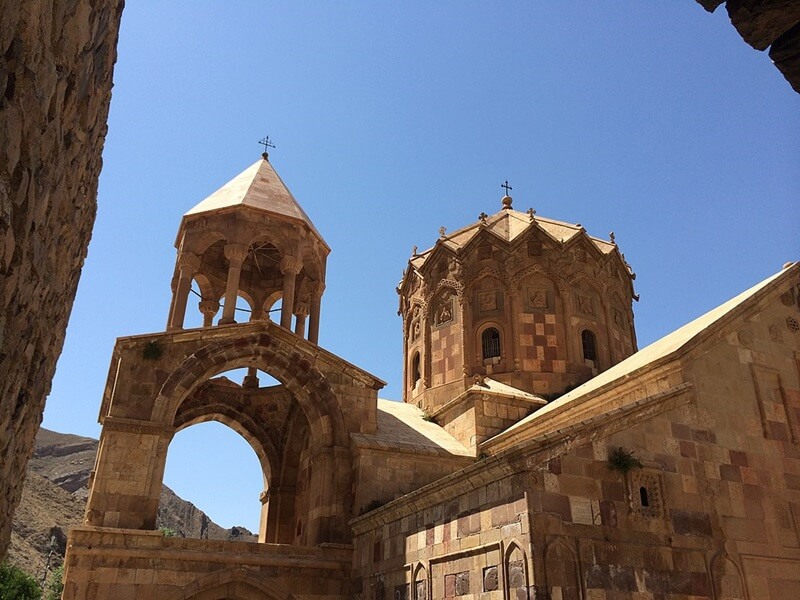
📷 Photo by Sam224616 from Wikicommons
Armenian Monastic Ensembles: A Spiritual Crossroads
Located in the scenic provinces of West and East Azerbaijan in northwest Iran, the Armenian Monastic Ensembles are among the most unique UNESCO World Heritage Sites in the country. These three ancient monasteries highlight centuries of cultural and religious exchange between Armenian and Persian civilizations.
The most prominent of the group is St. Thaddeus Monastery, a sacred pilgrimage site with origins dating back to the Sassanid period. Despite enduring earthquakes and wars, the monasteries have been carefully preserved, showcasing their resilience and spiritual importance.
Each monastery features distinct architectural influences, reflecting the diverse historical layers of the region:
- St. Thaddeus Monastery: A harmonious blend of Armenian and Persian architectural styles, showcasing the region’s cultural convergence.
- Saint Stepanos Monastery: Fusing Parthian, Roman, and Greek influences, this monastery embodies the historical crossroads of ancient civilizations.
- Chapel of Dzordzor: Predominantly Armenian architecture, enriched with Persian elements, reflecting the evolution of religious structures in the region.
Together, these sites represent a spiritual and cultural bridge—where different faiths and artistic traditions met, blended, and endured. Their unique blend of architecture and history makes the Armenian Monastic Ensembles a powerful symbol of coexistence and heritage in Iran’s northwest.
Bam and its Cultural Landscape: Ancient Urban Planning
Located on the Iranian central plateau in Kerman Province, Bam and its Cultural Landscape is one of Iran’s most iconic UNESCO World Heritage Sites. This ancient city dates back to the Achaemenid period (6th to 4th centuries B.C.) and played a key role as a trading hub along the historic Silk Road.
Bam is best known for its impressive mud-brick architecture, especially the Arg-e Bam, the largest adobe structure in the world. Its layout reflects advanced urban planning, with defensive walls, watchtowers, and a well-organized network of buildings that once formed a thriving medieval town.
One of Bam’s most remarkable features is its qanāt system—underground water channels that provided sustainable irrigation in the desert for over 2,000 years. These ancient engineering solutions show how early civilizations adapted to harsh environments with innovation and precision.
Although a major earthquake in 2003 caused severe damage, the site has since been carefully restored under UNESCO’s supervision. Today, Bam stands as a powerful symbol of resilience, architectural heritage, and the ingenuity of early urban planning in Iran’s arid regions.
Bisotun: Stories Carved in Stone
High on the limestone cliffs of western Iran lies Bisotun, a monumental record of ancient power and communication. This UNESCO World Heritage Site is most famous for its massive bas-relief and multilingual inscriptions commissioned by Darius I in 521 BC. They tell the dramatic story of his rise to the throne and the consolidation of the Persian Empire.
What makes Bisotun especially significant is its use of three ancient languages—Old Persian, Elamite, and Babylonian—offering one of the earliest known examples of royal propaganda in written form. These carvings are not only an artistic achievement but also a vital source for historians and linguists studying the Achaemenid period.
Positioned along a key ancient trade route, Bisotun became a meeting point for various civilizations. Over time, it gathered traces from different eras, including Median and Parthian remains, enriching its historical layers.
With its powerful visual storytelling and strategic location, Bisotun captures the ambition and sophistication of early Persian rule—a message from antiquity etched permanently into stone.
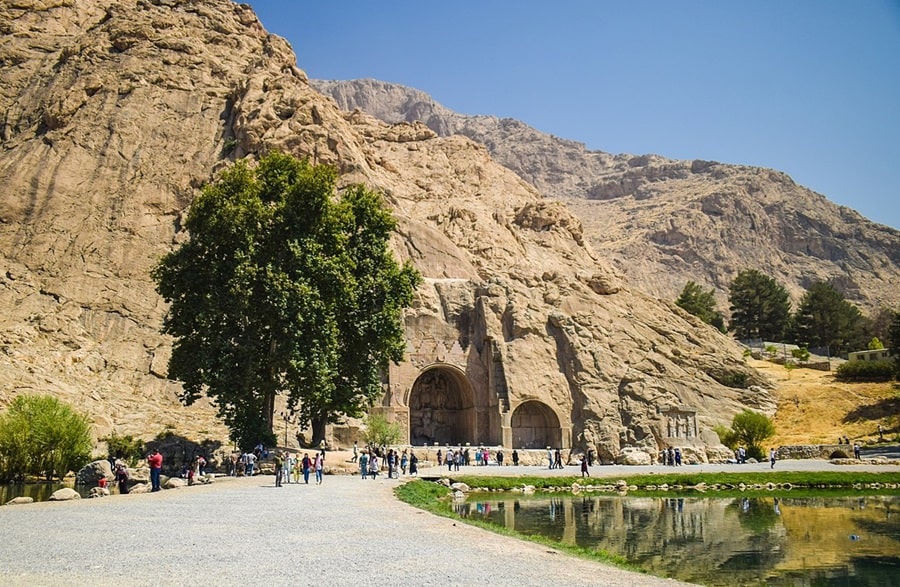
Cultural Landscape of Hawraman/Uramanat: A Living Heritage
Tucked away in the rugged mountains of Iran’s Kurdistan and Kermanshah provinces, the Cultural Landscape of Hawraman/Uramanat offers a striking example of how humans have harmoniously adapted to a challenging environment. Recognized as a UNESCO World Heritage Site in 2021, this region tells the story of the Hawrami people, a semi-nomadic community with deep cultural and historical roots.
What sets Hawraman apart is its terraced landscape, where villages appear to grow out of the mountains themselves. Traditional homes are built in a stepped layout, using local stone and wood, perfectly adjusted to the steep terrain. This unique architectural approach reflects generations of knowledge in sustainable living and environmental adaptation.
The site is composed of two main areas—the Central-Eastern Valley and the Western Valley—each showcasing centuries of agro-pastoral traditions, seasonal migration, and social customs that continue to this day. Unlike many heritage sites that preserve ruins of the past, Hawraman remains a living cultural landscape, where the rhythms of ancient life still shape daily routines.
With its breathtaking scenery and enduring way of life, the Cultural Landscape of Hawraman/Uramanat stands as a powerful reminder of the resilience and continuity of human culture in one of Iran’s most remote and beautiful regions.
Eager to explore Iran’s remarkable heritage?
Cultural Landscape of Maymand: Living Among the Rocks
In the heart of Iran’s Kerman province, the Cultural Landscape of Maymand offers a rare glimpse into an ancient way of life that has endured for thousands of years. Recognized as a UNESCO World Heritage Site, Maymand is famous for its hand-dug cave dwellings, carved into soft rock formations in a semi-arid valley surrounded by central Iranian mountains.
For over 2,000 years, the people of Meymand have lived in harmony with their environment, following a semi-nomadic agro-pastoral lifestyle. Their unique homes, cool in the summer and warm in the winter, reflect a deep understanding of sustainable living. Below the surface, an ancient underground irrigation system supports farming in this otherwise harsh landscape.
Archaeological finds—such as 6,000-year-old pottery and stone carvings from the Sassanid era—suggest that Meymand has been continuously inhabited since prehistoric times. These discoveries reveal the historical importance of the region, not only as a settlement but also as a crossroads for early civilizations.
More than just a relic of the past, Meymand remains a living cultural site. Its villagers still uphold the customs of their ancestors, preserving oral traditions, seasonal migration patterns, and agricultural practices that date back millennia. This remarkable harmony between humans and nature makes Maymand a true treasure of Persian heritage.
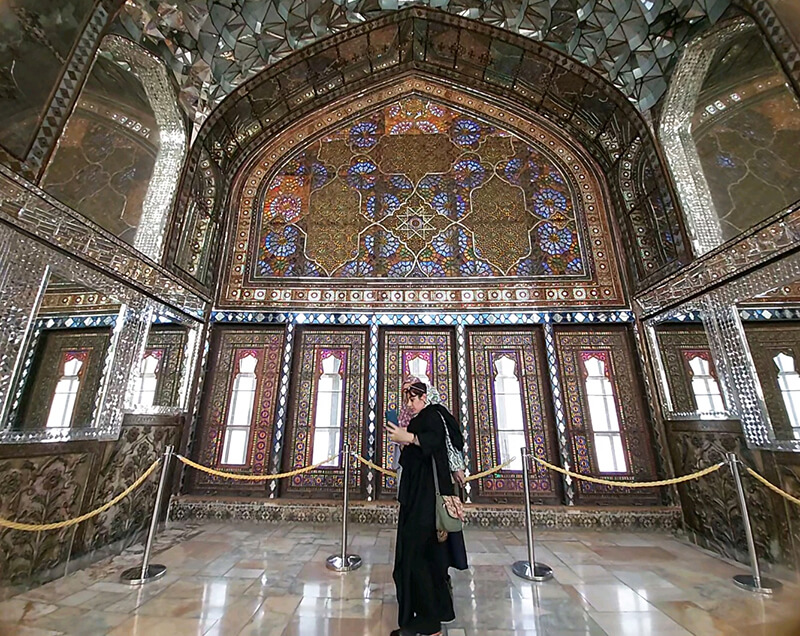
Golestan Palace: Qajar-Era Splendor in the Heart of Tehran
At the center of Tehran’s historic core, Golestan Palace stands as a dazzling example of 19th-century Persian opulence, crowned with a well-deserved place on the UNESCO World Heritage list. Originally built during the Safavid era, the palace was later expanded and reimagined under the Qajar dynasty, which made Tehran the capital in 1779. Golestan became not only the seat of royal power but also a showcase of evolving Persian architecture infused with European aesthetics.
The palace complex features a series of richly adorned halls, mirrored chambers, lush gardens, and iconic structures such as the Marble Throne, the Edifice of the Sun (Shams-ol-Emareh), and the Pond House (Howz Khaneh). Every corner reflects the royal tastes of the time, blending traditional Persian craftsmanship with influences from European art and design—a cultural exchange that flourished during the Qajar period.
Golestan Palace’s interiors are famed for their ornate tilework, mirror mosaics, and lavish frescoes, capturing the grandeur and lifestyle of Iran’s aristocracy in the 19th century. As one of the oldest historic monuments in the capital, it offers a vivid portal into the past—where diplomacy, ceremony, and art all came together in one majestic setting.
Whether you’re exploring its manicured gardens or admiring its stunning halls, Golestan Palace invites visitors to experience the fusion of East and West that defined a pivotal chapter in Iran’s architectural and political history.
Gonbad-e Qabus: Towering Over Time
Rising dramatically above the plains of Golestan province, Gonbad-e Qabus is one of Iran’s most iconic architectural landmarks. Built in 1006 AD during the Ziyarid dynasty, this UNESCO World Heritage Site is a striking example of early Islamic architecture—celebrated for its elegant design and lasting influence across the Islamic world.
Standing nearly 50 meters tall, the tower was constructed as the tomb of Qabus ibn Wushmgir, a local ruler and patron of the arts and sciences. Its tall, conical form and intricate geometric brickwork make it one of the earliest and most refined examples of vertical architectural design in the Islamic period.
More than just a mausoleum, Gonbad-e Qabus became a model for similar structures throughout Iran, Central Asia, and Anatolia, influencing sacred and monumental architecture for centuries. Its minimal ornamentation and pure geometric form represent a powerful aesthetic shift in Islamic art and engineering.

📷 Photo by Hadi Karami from Wikicommons
Today, this towering monument continues to impress visitors with its bold silhouette, mathematical precision, and historical depth—standing as a proud reminder of the Persian cultural and architectural legacy that transcends borders and eras.
Hegmataneh (Ecbatana): Echoes of an Ancient Capital
Among the oldest cities in Iran, Hegmataneh—also known by its Greek name, Ecbatana—stands as a powerful symbol of Iran’s early civilization. Located in modern-day Hamedan, this ancient city once served as the capital of the Median Empire and later became a key administrative center under the Achaemenid and Parthian dynasties.
Hegmataneh played a central role in shaping early Persian governance and culture. Its layout reveals traces of sophisticated urban planning, while ongoing excavations have uncovered clay tablets, inscriptions, and fortified structures that point to a high level of architectural and administrative advancement in antiquity.
The site’s layered history makes it a living archive of ancient empires that influenced not only Persia but also the wider region. Walking through its remains offers a rare glimpse into how some of the world’s first imperial cities were organized and operated.
Though much of it lies beneath the modern city, Hegmataneh’s archaeological core continues to reveal its secrets—making it an essential destination for anyone interested in the origins of Iranian civilization.
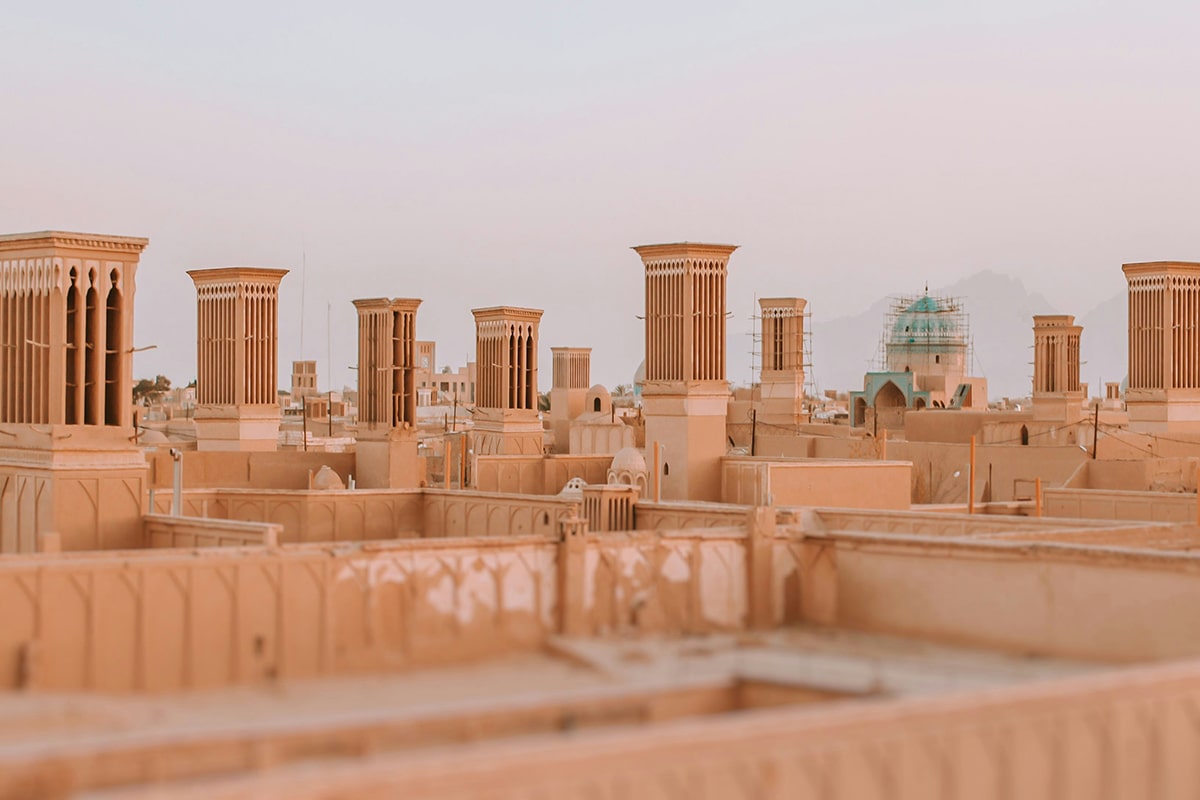
Historic City of Yazd: Desert Heritage and Ingenious Design
In the heart of Iran’s central plateau lies the Historic City of Yazd, a UNESCO World Heritage Site that beautifully illustrates the art of desert living. Continuously inhabited for over 2,500 years, Yazd is one of the oldest cities in the world, known for its remarkable adaptation to the harsh desert environment through innovative urban planning and vernacular architecture.
Often referred to as the “City of Windcatchers”, Yazd is famed for its badgirs—traditional ventilation towers that naturally cool buildings. These iconic features, along with adobe houses, mudbrick alleyways, and hidden courtyards, define the city’s distinctive skyline and architectural charm.
A central feature of Yazd’s survival in such arid conditions is its qanat system—a network of gently sloped underground channels that has supplied water for centuries. This ingenious irrigation method not only sustained agriculture but also made urban life possible in one of Iran’s driest regions.
Yazd is also a spiritual center for Zoroastrians, home to fire temples that preserve one of the world’s oldest monotheistic religions. With its vibrant bazaars, ancient mosques, and deeply rooted cultural identity, Yazd stands as a living museum of Persian resilience and creativity.
Jameh Mosque of Isfahan: A Living Chronicle of Persian Architecture
The Jameh Mosque of Isfahan—also known as Masjed-e Jāmé—is a timeless masterpiece that traces the evolution of Islamic architecture over more than twelve centuries. Recognized as a UNESCO World Heritage Site in 2012, it stands proudly in the heart of Isfahan, offering a vivid reflection of Iran’s cultural, religious, and architectural heritage.
Constructed primarily during the Seljuk Empire, the mosque showcases the influential Sassanid four-iwan courtyard layout, a design that would go on to shape mosque architecture across Central Asia. Over time, it was expanded and restored during the Ilkhanid, Timurid, and Safavid periods, each layer adding a new dimension to its already impressive structure. Today, it spans more than 20,000 square meters, making it one of the largest and oldest congregational mosques in Iran.
What makes the Jameh Mosque extraordinary is its ability to seamlessly fuse various architectural styles while maintaining a coherent identity. From the elegant brick domes and muqarnas vaulting to the calligraphic inscriptions and intricate tilework, every corner of the mosque tells a story of artistic innovation and spiritual devotion.
More than just a monument, the Jameh Mosque is a living sanctuary—a place where the echoes of centuries past still resonate through its stone corridors and prayer halls. It stands not only as a symbol of Persian ingenuity but also as a living archive of Islamic and Iranian architectural evolution.
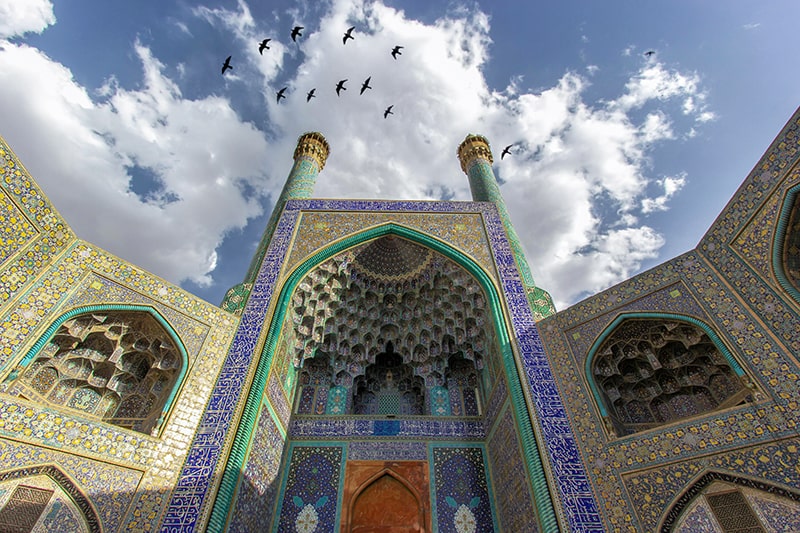
Naqsh-e Jahan Square: An Architectural Masterpiece of Safavid Persia
At the heart of Isfahan lies Naqsh-e Jahan Square, one of the grandest and most visually stunning public spaces in the world. Commissioned in the early 17th century by Shah Abbas I, this UNESCO World Heritage Site is a sublime example of Safavid urban planning and Persian architecture at its zenith.
The square, whose name translates to “Image of the World,” is framed by architectural masterpieces that speak to Iran’s artistic and religious heritage. The Imam Mosque, with its dazzling blue tilework, the Sheikh Lotfollah Mosque, known for its quiet elegance, and the towering Ali Qapu Palace, with its panoramic views and richly painted music room, all converge to form a harmonious ensemble. The square itself is lined with two-story arcades and anchored by the Qaysariyyeh Bazaar entrance, where centuries of trade and cultural exchange come alive.
Naqsh-e Jahan is not just a historical site—it’s a living, breathing space that continues to host gatherings, artisans, and travelers. Every stone and tile tells a story of Persia’s golden era, making a visit here an unforgettable journey through time and grandeur.
Persepolis: The Timeless Symbol of the Achaemenid Empire
Rising from the plains of Fars Province, Persepolis—known in Persian as Takht-e Jamshid—is the awe-inspiring ceremonial capital of the Achaemenid Empire. Founded by Darius I around 518 BCE, this monumental complex is a powerful expression of imperial ambition, artistic brilliance, and architectural mastery.
Approaching the site, one ascends the grand staircase, which leads to a platform adorned with majestic ruins. The Gate of All Nations, flanked by winged bulls, welcomes visitors into a world of stone reliefs and towering columns. The Palace of Xerxes, Apadana, and other majestic halls offer a glimpse into the ceremonial heart of one of the ancient world’s greatest empires.
Even in partial ruin, Persepolis conveys the sheer scale and sophistication of Achaemenid civilization. Despite its destruction by Alexander the Great, the site continues to echo with the pride of a culture that once spanned three continents. Every carving and inscription whispers of kings, subjects, rituals, and a legacy that endures through the ages.
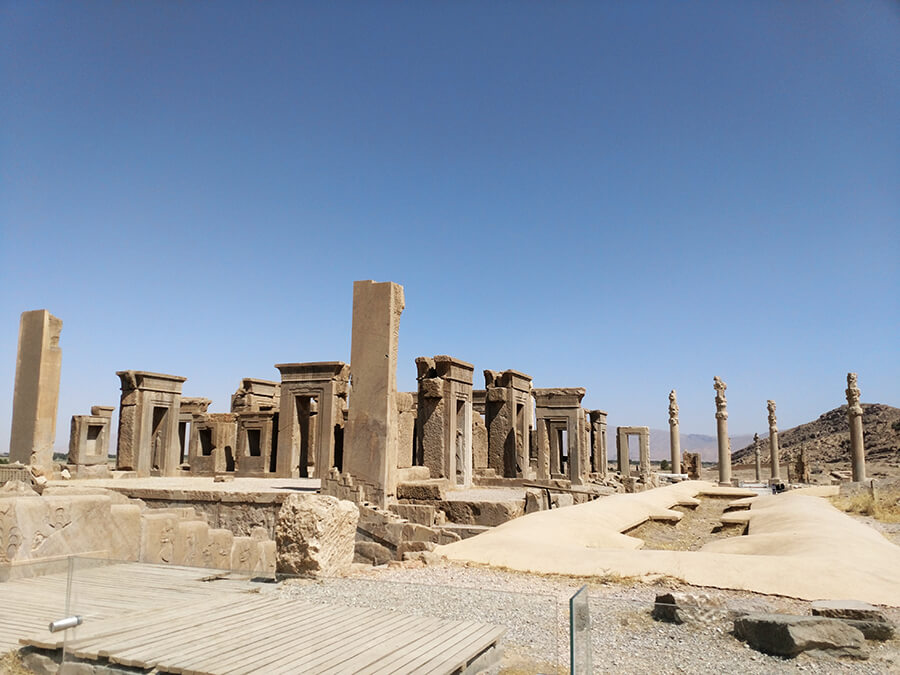
Pasargadae: Eternal Legacy of Cyrus the Great
Amid the windswept Murgab Plain in southern Iran lies Pasargadae, the first capital of the Persian Empire and the resting place of its visionary founder, Cyrus the Great. Designated a UNESCO World Heritage Site, Pasargadae is a solemn yet powerful reminder of ancient Persia’s early grandeur.
Founded in the 6th century BCE, the city reveals the genesis of Achaemenid architecture—a unique fusion of Mesopotamian, Elamite, and Anatolian influences. At its heart stands the Mausoleum of Cyrus, a simple yet imposing structure that has inspired awe for over two millennia. Nearby ruins of palaces, audience halls, and administrative buildings hint at the city’s former splendor.
Pasargadae is also home to the earliest known example of the Persian Chahar Bāgh garden—a quadrilateral layout that would later become a hallmark of Persian garden design. Though quieter and more understated than Persepolis, Pasargadae speaks volumes about the foresight, governance, and cultural foundations laid by Cyrus the Great, whose legacy continues to shape Iranian identity to this day.
The Sassanid Archaeological Landscape: Legacy of an Ancient Empire
In the rolling landscapes of southern Fars Province, the Sassanid Archaeological Landscape offers a remarkable journey into the heart of one of Persia’s most sophisticated civilizations. Recognized as a UNESCO World Heritage Site in 2018, this expansive area encompasses the ancient cities of Firouzabad, Sarvestan, and Bishapour, each echoing the grandeur and ingenuity of the Sassanid Empire.
At the core of the site lies the Sarvestan Palace, built in the 5th century AD. With its domed halls and monumental arches, the structure functioned both as a royal residence and a Zoroastrian fire temple, reflecting the duality of state and spirituality in Sassanian governance. Surrounding these ruins are a rich array of inscriptions, fortresses, ceremonial complexes, and even a sacred cave, all speaking to the empire’s architectural brilliance and administrative sophistication.
Walking through the remnants of these ancient cities, visitors are immersed in a world where Persian art, urban planning, and religious symbolism converge. The Sassanid Archaeological Landscape captures the power, pride, and enduring influence of an empire that laid the cultural foundations for later Persian dynasties.
Eager to explore Iran’s remarkable heritage?
Shahr-i Sokhta: The Burnt City of the Bronze Age
In the arid plains of Sistan and Baluchestan, the ruins of Shahr-i Sokhta, or the Burnt City, rise like a mirage from the desert—silent witnesses to a flourishing civilization that thrived over five millennia ago. Dating back to 3200 BCE, this extraordinary site was once a bustling center of trade, innovation, and urban life during the Bronze Age.
Declared a UNESCO World Heritage Site in 2014, Shahr-i Sokhta is renowned for its advanced urban planning. Archaeologists have uncovered complex water management systems, designated residential and industrial zones, and traces of highly skilled craftsmanship in pottery, metalwork, and jewelry. These discoveries suggest a society with deep knowledge, artistry, and far-reaching trade connections that extended across ancient Asia.
Situated at the crossroads of key commercial routes, the city played a vital role in cultural exchange. Despite its decline and mysterious abandonment, Shahr-i Sokhta continues to intrigue scholars and visitors alike. Its preserved remains tell a compelling story of resilience and ingenuity, offering a rare glimpse into the early evolution of organized civilization in the Iranian plateau.
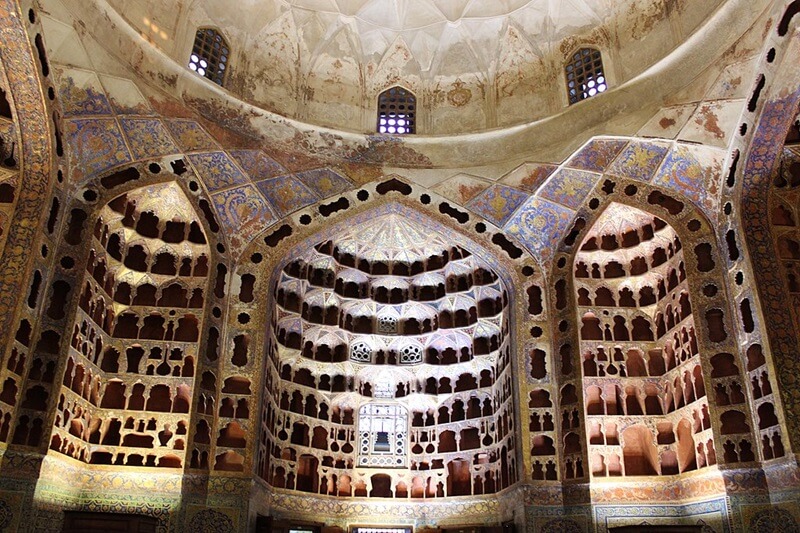
📷 Photo by Ali Shafizadeh from Wikicommons
Sheikh Safi al-Din Ensemble: The Soul of Sufism in Ardabil
In the historic city of Ardabil, nestled beneath the towering peaks of northwestern Iran, lies the Sheikh Safi al-Din Khānegāh and Shrine Ensemble—a serene and sacred space that captures the spiritual heart of Persian Sufism. This UNESCO World Heritage Site weaves together religion, art, and architecture, standing as both a Sufi sanctuary and a masterwork of Safavid-era urban design.
Built around the tomb of Sheikh Safi al-Din, the revered 13th-century mystic and spiritual ancestor of the Safavid dynasty, the complex blossomed into a spiritual city within a city. Featuring a mosque, school, courtyard, public bath, and even sections of the old bazaar, the ensemble served as a center of Sufi learning and pilgrimage.
The site’s exquisite tilework, carved stucco, calligraphy, and delicate muqarnas details reflect the artistic mastery of the period. It embodies the Persian-Islamic architectural fusion that defines much of Iran’s heritage. As a center of faith and scholarship, the Sheikh Safi ensemble reminds us of the deep spiritual undercurrents that flowed through Safavid culture and its enduring reverence for Sufi philosophy.
Shushtar Historical Hydraulic System: Ancient Engineering in Motion
In the sunbaked province of Khuzestan, the city of Shushtar boasts one of the most extraordinary examples of ancient engineering—the Shushtar Historical Hydraulic System. This UNESCO World Heritage Site is not only a marvel of Persian ingenuity but also a living legacy, still partially functional after more than two millennia.
Initially conceived during the Achaemenid era and later expanded by Sassanid engineers, the system represents a complex network of canals, tunnels, watermills, bridges, and dams. Together, they managed the Karun River’s flow to irrigate vast agricultural lands and power flour mills, supporting a thriving urban civilization.
What makes the Shushtar system unique is its seamless integration of function and form. Structures like the Gargar Bridge-Dam and Salasel Castle demonstrate a mastery of hydrodynamics and construction techniques rarely seen in antiquity. It’s a vivid reminder that water was not only a life-sustaining resource but a source of technological inspiration and social organization.
Today, the site continues to awe engineers and historians alike, offering insight into the practical brilliance and ecological foresight of ancient Persia’s builders.
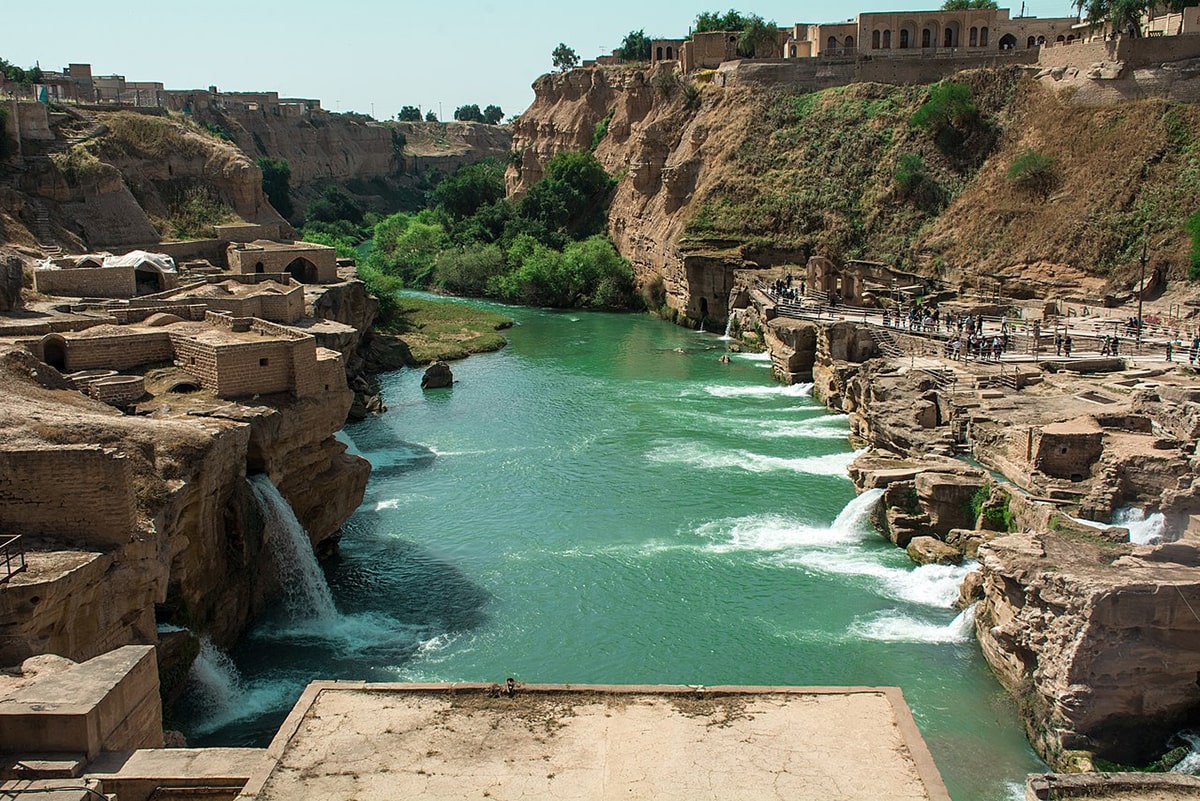
Soltaniyeh Dome: A Jewel of Ilkhanid Innovation
In the heart of Zanjan Province, the majestic Soltaniyeh Dome rises from the skyline like a turquoise crown, proclaiming the architectural genius of 14th-century Persia. Built as the final resting place of Oljaytu, a ruler of the Ilkhanid dynasty, this UNESCO World Heritage Site stands as one of the most ambitious architectural projects of its time—and to this day, remains the third-largest brick dome in the world.
The dome’s double-shelled structure, cloaked in striking turquoise faience tiles, showcases a masterful blend of structural innovation and spiritual symbolism. The scale, geometry, and acoustics of Soltaniyeh’s mausoleum were groundbreaking, influencing Islamic architecture far beyond Iran’s borders. Many scholars believe its design helped pave the way for iconic buildings like the Taj Mahal, underscoring Persia’s architectural influence across empires.
Wandering beneath its towering arches, one can’t help but marvel at the ingenuity that fused faith, geometry, and aesthetics into such a timeless monument. Soltaniyeh is not just a dome—it’s a bridge between East and West, past and present, and a shining symbol of Persian architectural excellence.
The Ancient City of Susa: Where Empires Met
Few places in the world carry the historic weight of Susa, an ancient city nestled between the Dez and Karkheh rivers in Khuzestan Province. With origins dating back to 4000 BCE, Susa is among the world’s oldest continuously inhabited cities and a former capital of the Elamite, Achaemenid, and Parthian empires. Designated as Iran UNESCO World Heritage Site, this remarkable city was a true crossroad of civilizations.
At its heart lie the Palace of Darius the Great and the grand Apadana Hall, remnants of the city’s Achaemenid glory. Nearby, the Susa Acropolis rises with its ancient foundations, offering a commanding view of this once-mighty capital. One of the most profound discoveries from Susa is the Code of Hammurabi, uncovered by French archaeologists—a testament to the city’s far-reaching significance in ancient law and governance.
Beyond its palaces and ruins, Susa reveals intimate glimpses into the lives of its ancient people. The surrounding burial grounds, with over 2,000 excavated graves, speak volumes about the city’s spiritual and social evolution over millennia. Visiting Susa is like walking through the epic narrative of ancient Persia—a story of power, culture, and enduring legacy etched in every stone.
Tabriz Historic Bazaar Complex: A Living Legacy of Trade
Tucked within the bustling city of Tabriz in East Azerbaijan Province, the Tabriz Historic Bazaar Complex pulses with the rhythm of centuries-old commerce and culture. As one of the oldest bazaars in the Middle East and among the largest covered marketplaces in the world, this UNESCO World Heritage Site is a testament to the vibrant soul of Persian trade.
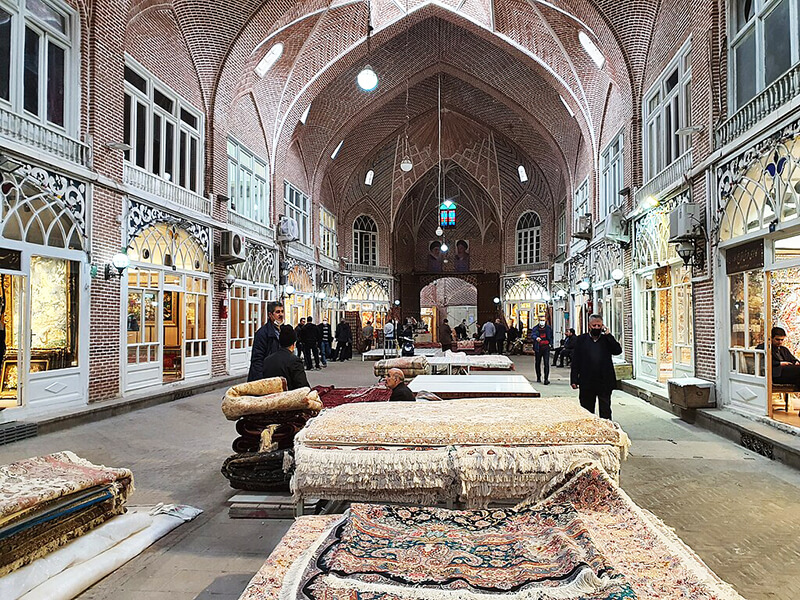
📷 Photo by Mohadeseh N.de, via Wikimedia Commons
Dating back to at least the 13th century, the bazaar flourished during the Safavid dynasty, when Tabriz was the capital and a major artery of the Silk Road. Its labyrinthine network of brick-vaulted alleys, caravanserais, mosques, and madrassas once hosted merchants from China, India, Central Asia, and Europe—making it a melting pot of goods, languages, and ideas.
Today, the bazaar remains a living museum. Visitors can stroll through its atmospheric passageways, discovering handwoven Persian carpets, delicate pottery, fine leatherwork, and timeless craftsmanship passed down through generations. Each corridor whispers stories of prosperity, tradition, and resilience.
To walk through the Tabriz Bazaar is to immerse yourself in the enduring rhythm of Iranian life, where commerce and culture have coexisted for centuries beneath intricately vaulted ceilings.
Takht-e Soleyman: A Sacred Center of Fire and Water
Tucked into the rolling hills of West Azerbaijan Province, Takht-e Soleyman—the “Throne of Solomon”—is one of the most mystical and spiritually significant Iran UNESCO World Heritage Sites. With a history stretching back over 2,500 years, this sacred complex served as a key religious and political center during the Sasanian Empire, and possibly earlier under Median and Parthian rule.
At the heart of the site lies a Zoroastrian fire temple, believed to have housed the eternal sacred flame, making it one of the most revered sanctuaries of the ancient world. Nearby, a crater lake known as Zendan-e Soleyman (“Solomon’s Prison”) adds an enigmatic aura, steeped in local legends. The site also includes the Royal Temple of Anahita, dedicated to the goddess of water—further reinforcing the symbolic balance of fire and water.
Takht-e Soleyman’s influence extended far beyond Iran’s borders. During the Mongol era, it inspired the architectural design of summer palaces and ceremonial centers across Asia. Its harmonious layout, blending natural geography with cosmic symbolism, offers deep insight into Persian spirituality and imperial grandeur.
Today, the ruins stand as a powerful reminder of Iran’s ancient religious traditions and the architectural genius of its ancestors.
Chogha Zanbil Ziggurat: Towering Echoes of Elamite Splendor
In the plains of Khuzestan Province, the monumental Ziggurat of Chogha Zanbil rises as one of the most striking remnants of the Elamite civilization—a people who flourished long before the Persians. Constructed around 1250 BCE by King Untash-Napirisha, this ancient religious complex is home to the largest and best-preserved ziggurat in Iran.
Originally built to honor Inshushinak, the Elamite god of Susa, the stepped pyramid reflects an advanced understanding of engineering and sacred design. Surrounding the ziggurat were temples, palaces, and an elaborate water management system—evidence of the Elamites’ mastery of hydraulic technology and urban planning.
Declared a UNESCO World Heritage Site in 1979, Chogha Zanbil was one of the first Iranian sites to receive this honor. Its timeless structure, made of sun-dried bricks and adorned with cuneiform inscriptions, tells the story of a lost civilization whose influence echoed through the centuries.
For modern visitors, Chogha Zanbil offers a rare chance to stand before a towering relic of the ancient Near East, where faith, power, and ingenuity converged.
Persian Gardens: Where Earth Meets Paradise
Across the diverse landscapes of Iran, Persian Gardens stand as living masterpieces of design, philosophy, and culture—recognized collectively by UNESCO as expressions of the Persian ideal of paradise on Earth. Carefully curated from the Achaemenid to Qajar eras, these gardens reflect a deep spiritual and architectural tradition rooted in harmony between humans and nature.
The iconic Chahar Bāgh (Four Gardens) layout divides space into four quadrants, symbolizing the Zoroastrian elements—earth, water, air, and fire—and guiding flowing water through elegant channels and pools. These gardens were not only places of leisure and reflection but also represented divine order and royal power.
Among the nine Persian Gardens inscribed by UNESCO, each adapted ingeniously to its environment—from the desert oasis of Fin Garden in Kashan to the alpine setting of Eram Garden in Shiraz. The prototype, however, lies in Pasargadae, built by Cyrus the Great, setting a precedent for centuries of garden design throughout the Islamic world and beyond.
Whether visited in spring bloom or autumnal quiet, Persian Gardens continue to inspire with their timeless elegance—where architecture, water, and vegetation converge in a poetic dialogue of beauty and balance.
Persian Caravanserais: Hubs of Trade and Hospitality
Scattered across 24 provinces of Iran, the Persian Caravanserais form a stunning network of 57 historical inns, collectively inscribed on the Iran UNESCO World Heritage list. These remarkable structures once served as vital stops along ancient trade routes, including the famed Silk Road, offering safe rest and respite for travelers, merchants, and pilgrims.

Each caravanserai exemplifies Persian architectural excellence, harmoniously blending form and function. Typically built with brick, stone, or adobe, they feature grand courtyards, arched iwans, and fortified walls designed to withstand time and terrain.
Notable examples include:
- Noshirvan and Sheykh Ali Khan Caravanserais in Isfahan Province, celebrated for their elegant design and strategic importance.
- The Anjireh Caravanserais in Yazd Province, constructed from rock and brick, showcasing regional adaptations and artistry.
These roadside complexes are more than architectural relics—they are cultural landmarks reflecting Iran’s legacy of hospitality, innovation, and connectivity. Their enduring presence tells the story of Shah Abbas I’s expansive infrastructure reforms and the thriving exchanges between East and West.
Persian Qanats: Ancient Waterways of Innovation
Among the greatest engineering feats of the ancient world, Persian Qanats exemplify the ingenuity of early Iranian civilizations in managing water resources. These subterranean aqueducts, built over millennia, channeled groundwater from arid mountain regions to populated settlements—transforming deserts into fertile lands.
Today, eleven qanats across Iran are recognized by UNESCO as World Heritage Sites. Noteworthy among them:
- The Zarch Qanat in Yazd, stretching over 80 kilometers and dating back 3,000 years, is the world’s longest qanat still in use.
- The Qasbeh Qanat in Gonabad, 2,500 years old, traces its origins to the Achaemenid Empire and remains a marvel of ancient hydrology.
These systems supported the growth of urban centers, agriculture, and trade, demonstrating a deep understanding of geography and sustainable resource use. Built using only gravity, tools, and human labor, Persian Qanats remain a living legacy of Iran’s technological and cultural resilience.
Lut Desert: Earth’s Fiery Masterpiece
In Iran’s southeastern heartland, the Lut Desert (Dasht-e Lut) unfolds in a dramatic landscape of extremes. Spanning parts of Kerman and Sistan & Baluchestan Provinces, this UNESCO-listed natural wonder is one of the hottest places on Earth, with satellite-recorded surface temperatures exceeding 70°C (158°F).
But heat is just the beginning. The Lut’s terrain is carved by millennia of wind and water erosion, forming mesmerizing features like:
- Towering yardangs (wind-sculpted ridges)
- Shifting sand seas
- Polished rock plateaus and vast salt flats
With no vegetation in its core, the Lut Desert offers a haunting beauty—a living laboratory of geological time and environmental extremes. Its stark isolation and otherworldly vistas make it one of the most surreal and unforgettable natural landscapes on the planet.
As one of Iran’s two natural UNESCO World Heritage Sites, the Lut Desert is a global treasure, capturing the raw power and silent poetry of nature.
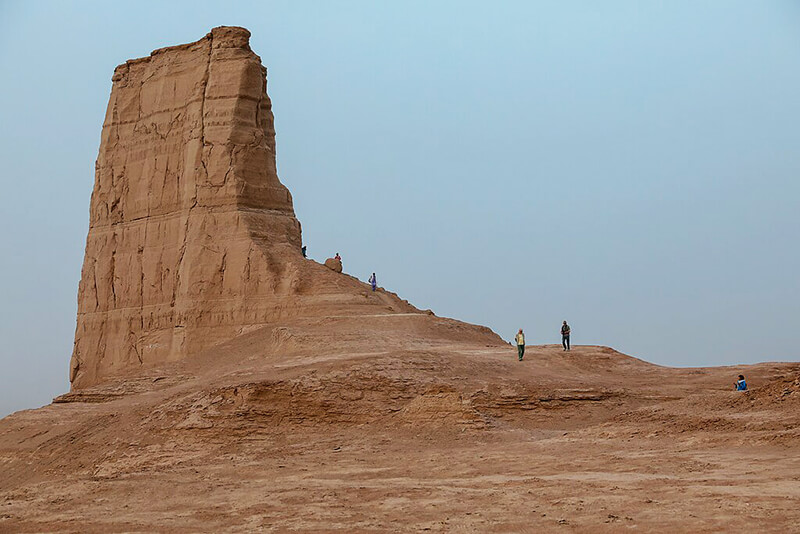
📷 Photo by Ninara from Wikicommons
Hyrcanian Forests: Iran’s Ancient Green Legacy
Stretching along the southern shores of the Caspian Sea, the Hyrcanian Forests are a living relic of Earth’s prehistoric past. Dating back over 50 million years, these dense, humid woodlands are among the oldest deciduous forests in the world, often referred to as “living fossils.”
Covering the provinces of Gilan, Mazandaran, Golestan, Ardabil, Semnan, and parts of Azerbaijan, the Hyrcanian Forests are a UNESCO World Heritage Site celebrated for their extraordinary biodiversity and ecological value.
Key facts:
- Jurassic-era origins
- Home to 3,200+ plant species and rare wildlife like the Persian leopard and brown bear
- One of the last temperate rainforests in the Northern Hemisphere
These ancient forests are a vital natural refuge, playing a key role in climate regulation, water preservation, and the cultural identity of local communities. Their preservation ensures that future generations can continue to marvel at a truly primeval ecosystem that has flourished through the ages.
Trans-Iranian Railway: A Monument of Modern Engineering
Spanning 1,394 kilometers from the Caspian Sea in the north to the Persian Gulf in the south, the Trans-Iranian Railway stands as a monumental symbol of early 20th-century ingenuity. Recognized as a UNESCO World Heritage Site, this rail line crosses four climatic zones—traversing mountains, rivers, highlands, plains, and forests—while connecting diverse communities across Iran’s complex terrain.
Constructed between 1927 and 1938, the railway was a landmark collaboration between the Iranian government and 43 international contractors, blending local vision with global expertise. The result was a triumph of civil engineering, completed without relying on colonial funding—a rare achievement for the time.
Structural Highlights:
- Large Bridges: 174
- Small Bridges: 186
- Tunnels: 224, including 11 spiral tunnels
From mountain-cut passes to ingenious bridge networks, the Trans-Iranian Railway showcases not only technical excellence but also Iran’s strategic ambition during a pivotal era of modernization. Today, it remains a crucial component of the national transport system, linking major cities and trade hubs while preserving a powerful legacy of architectural and cultural resilience.
Iran’s UNESCO Tentative List: Future World Heritage Sites
Beyond its current UNESCO-designated landmarks, Iran is home to a remarkable 58 sites on UNESCO’s Tentative List, each awaiting potential recognition as a World Heritage Site. These cultural and natural gems offer a window into Iran’s deep-rooted history, environmental diversity, and architectural grandeur.
Here are a few standout contenders:
- Ali-Sadr Cave (Hamadan Province): One of the world’s largest water caves, famed for its vast chambers, turquoise waterways, and stunning speleothems.
- Mount Damavand (Mazandaran Province): The highest volcano in Asia and a symbol of Persian mythology, this majestic peak invites climbers and nature lovers to explore its snow-capped summit and geothermal springs.
- Natural Marvels of Qeshm Island: Stretching across the Strait of Hormuz, Qeshm Island showcases extraordinary ecological diversity, geological formations, and historical significance—offering a unique convergence of natural and cultural heritage.
These and many more sites—from ancient urban settlements to unique ecosystems—showcase Iran’s unmatched cultural and ecological wealth. As they await formal inscription, they underscore Iran’s position as a crossroads of civilizations and a treasure trove of human and natural heritage.
Final Thoughts: A Tapestry Woven in Time and Nature
From the sacred fires of Takht-e Soleyman to the silent sands of the Lut Desert, Iran’s UNESCO World Heritage Sites reveal a land shaped by millennia of ingenuity, devotion, and coexistence with nature. Each site—whether carved by ancient hands or sculpted by the forces of geology—offers a glimpse into a civilization that has long celebrated beauty, resilience, and meaning in every corner of its landscape.
These enduring landmarks are not only milestones of world heritage but also doorways into Iran’s deeper story—one best experienced slowly, across cities, mountains, deserts, and gardens. Whether drawn by history, culture, or the sheer wonder of nature, those who explore these sites discover more than monuments—they uncover the living spirit of a place where time still speaks.
Let this be your invitation to journey thoughtfully through Iran, allowing its past and present to meet you along the way.
Let’s Plan Your Iran UNESCO Sites Tour Together
FAQs about Iran UNESCO World Heritage Sites
1. How many UNESCO World Heritage Sites are there in Iran?
Iran is home to 28 UNESCO World Heritage Sites, comprising both cultural and natural landmarks. These range from ancient cities and architectural marvels to unique natural ecosystems like the Lut Desert and Hyrcanian Forests.
2. Do I need a special permit to visit UNESCO sites in Iran?
Most UNESCO sites in Iran are open to the public and do not require special permits, although some may have entrance fees or restricted areas. Always check local guidelines, especially for sites in protected zones like national parks or religious complexes.
3. Are guided tours recommended for these sites?
Yes, guided tours are highly recommended, especially for historical and archaeological sites. Knowledgeable local guides can provide invaluable context, storytelling, and cultural insight that enrich the experience.
4. What’s the best time to visit UNESCO sites in Iran?
Spring (March to May) and autumn (September to November) are ideal for exploring most of Iran, offering pleasant weather for both cultural and natural sites. Desert regions like the Lut are best visited in cooler months.
5. Are UNESCO sites in Iran accessible for all travelers?
Accessibility varies. Major cities and well-known landmarks like Persepolis and Naqsh-e Jahan Square are relatively accessible. However, some remote sites or natural landscapes may have limited infrastructure or require moderate physical activity.
6. Can I take photographs at UNESCO sites in Iran?
Photography is generally allowed at most sites, but flash photography or drone use may be restricted, especially in historical buildings or religious areas. Look for signage or consult your guide.
7. Are there UNESCO sites suitable for family travel?
Absolutely. Sites like Golestan Palace, The Persian Gardens, and Shushtar Historical Hydraulic System offer engaging experiences for all ages, while natural areas like Qeshm Island and the Hyrcanian Forests are great for outdoor adventures.
8. What should I wear when visiting cultural sites in Iran?
Visitors should follow Iran’s dress code, especially at religious or traditional sites. Modest clothing is required: women should wear a headscarf and long sleeves; men should avoid shorts.
9. Are all UNESCO sites easily reachable from major cities?
While many are near major cities like Tehran, Isfahan, Shiraz, and Yazd, others—such as the Armenian Monastic Ensembles or Tchogha Zanbil—may require longer journeys or dedicated planning. Tours can help streamline transportation.
10. How can I make the most of my visit to Iran’s UNESCO sites?
To truly experience the depth and diversity of Iran’s heritage, consider multi-day itineraries that combine several regions and site types—cultural, natural, and archaeological. Planning ahead with local expertise allows for a smoother, more enriching journey.


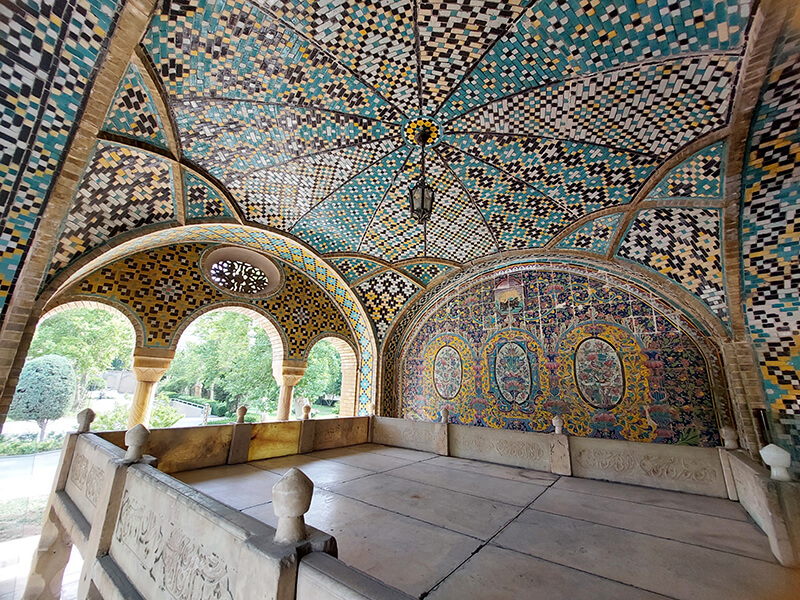
0 Comment